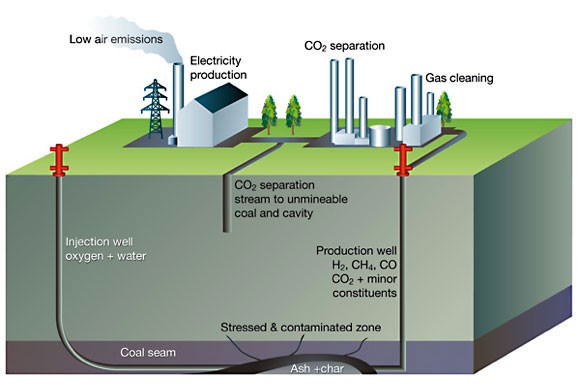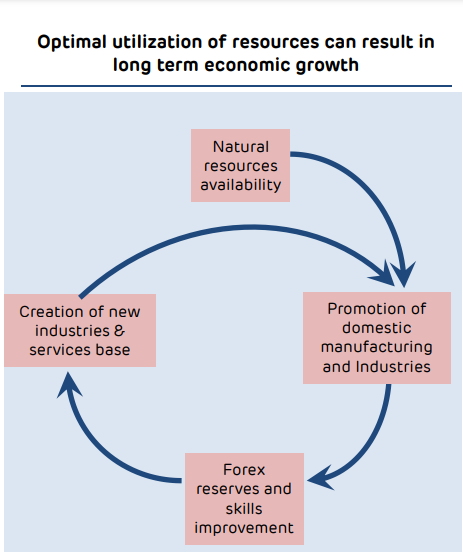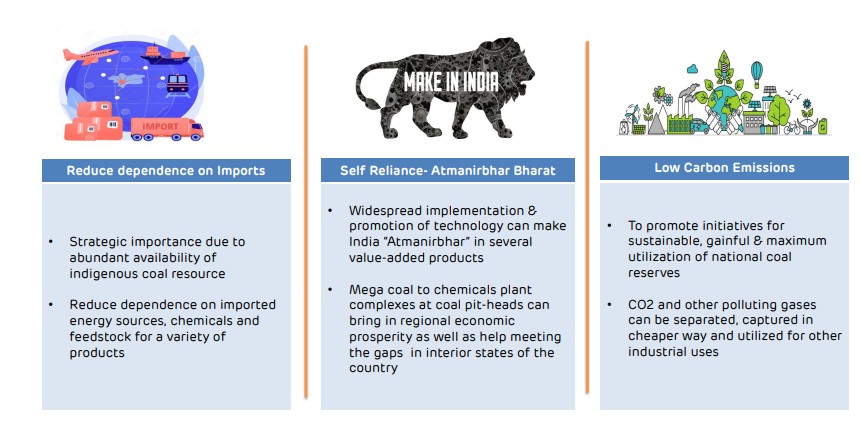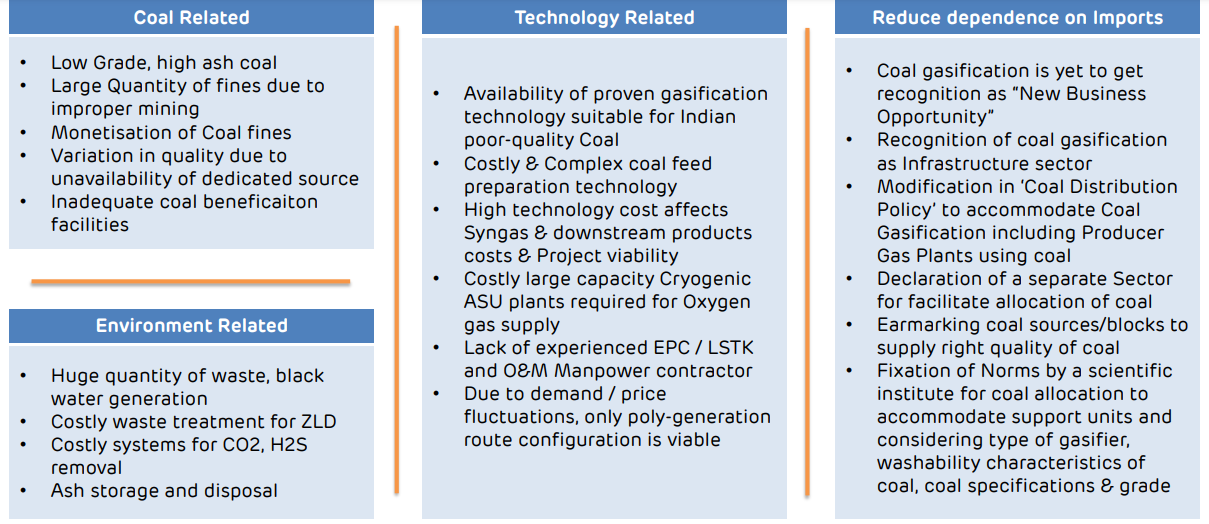Description

Disclaimer: Copyright infringement not intended.
Context
Coal Ministry to Host Industry Interaction in Hyderabad to Promote Coal/Lignite Gasification Projects in India
Details
Coal gasification
- Coal gasification is a thermochemical process that converts coal into a synthesis gas, or "syngas," by reacting coal with oxygen, steam, or a combination of both at high temperatures and pressures.
Process:
- Coal Preparation: Before gasification, coal undergoes preparation to remove impurities such as sulfur, ash, and moisture, which can interfere with the gasification process.
- Gasification: The prepared coal is reacted with oxygen, steam, or a mixture of both at high temperatures (typically above 700°C) in a gasifier. The main reactions include:
- Combustion Reaction: C + O₂ → CO₂
- Gasification Reactions: C + H₂O → CO + H₂ and C + CO₂ → 2CO
- These reactions produce a gas mixture known as syngas, consisting primarily of carbon monoxide (CO) and hydrogen (H2), along with other gases such as methane (CH4) and carbon dioxide (CO2).
- Gas Cleanup: The raw syngas contains impurities such as sulfur compounds, particulates, and tars. Gas cleanup processes such as desulfurization, particulate removal, and tar cracking are employed to purify the syngas.
Syngas Utilization:
The cleaned syngas can be used in various applications:
- Power Generation: Syngas can be burned in gas turbines or used in combined cycle power plants to generate electricity.
- Chemical Synthesis: Syngas serves as a feedstock for the production of chemicals such as methanol, ammonia, and synthetic natural gas (SNG).
- Fuel Production: Syngas can be further processed to produce liquid fuels such as diesel and gasoline through Fischer-Tropsch synthesis.
Advantages of Coal Gasification:
- Resource Utilization: Coal gasification enables the utilization of coal reserves that are otherwise economically impractical to mine or environmentally challenging to utilize.
- Emissions Reduction: Gasification produces a cleaner syngas compared to traditional coal combustion, allowing for easier capture and sequestration of pollutants such as sulfur and mercury.
- Efficiency: Gasification processes can achieve higher overall energy conversion efficiencies compared to conventional coal-fired power plants.
- Versatility: Syngas produced from coal gasification can be used in a wide range of applications, including power generation, chemical synthesis, and fuel production.

Challenges and Considerations:
- Cost: Coal gasification plants typically require high capital investment due to the complexity of the technology and the need for gas cleanup systems.
- Environmental Impact: While gasification reduces certain emissions compared to conventional coal combustion, it still produces greenhouse gases and requires careful management of waste streams and byproducts.
- Scale and Integration: Gasification technology may face scalability challenges, especially for smaller-scale applications or integration with existing infrastructure.
- Feedstock Flexibility: While coal is the primary feedstock for gasification, advancements in technology allow for the utilization of other carbonaceous materials such as biomass and municipal solid waste.
Need for Coal Gasification in India
- India can monetize abundantly available coal reserves through gasification to cater the growing energy and chemicals needs of the country.
- It is evident that India has huge reserves of coal, it would be beneficial for India if it finds a sustainable way of using these reserves as the world including India is gradually transitioning away from coal toward cleaner fuels in the wake of climate change.
- The use of domestic coal reserves becomes even more important, especially when India does not have other sources of fuel – crude oil and natural gas, 82% and 45% of the requirement of those fuels is met through imports. This exposes India to the vagaries of price volatility and supply insecurity.
- India will continue to depend on coal for its future energy needs at least till 2050 as per several reports. Since coal has to be used for coming 2 to 3 decades, there is an urgent need to make use of coal as green as possible
Optimal utilization of indigenous natural resources is critical for long term economic growth and competitive advantages:
- Socio Economic Development: Extraction of Natural Sources and developing ancillary industries is a capital intensive Employment and skill development
- Exports and Imports: Exports can rapidly rise while Imports will be reduced
- Government Revenue Natural Resources extraction has become a very significant source of total tax revenues
- FDI Increase: FDI inflow into the country
- Timely exploitation of Natural resources have helped countries in creating long term economic drivers E.g. Shale gas revolution in US , Coal to Chemicals in China. China produces more than 90% of its ammonia through coal gasification

Advantages of Coal Gasification in India

National Coal Gasification Mission
- Indian government aims for 100 million ton (MT) coal gasification by 2030, with investments worth over Rs. 4 trillion.
- In order to encourage the use of clean sources of fuel, the government has provided a concession of 20% on revenue share under commercial coal block auctions.
- A Steering Committee has been constituted regarding Surface Coal Gasification under the chairmanship of Dr. V.K. Saraswat and members from the Ministry of Coal.
- CIL has also planned to set up at least 3 gasification plants (besides Dankuni) on BOO basis through global tendering and has signed an MoU with GAIL for marketing synthetic natural gas.
Key Challenges

Status of coal in india
Distribution of Coal in India:
Gondwana coal fields (250 million years old)
- Gondwana coal makes up to 98 % of the total reserves and 99 % of the production of coal in India. Gondwana coal forms India’s metallurgical grade as well as superior quality coal.
- It is found in Damodar (Jharkand-West Bengal), Mahanadi (Chhattisgarh-Odisha), Godavari (Maharashtra), and Narmada valleys.
Tertiary coal fields (15 – 60 million years old):
- Carbon content is very low but is rich in moisture and sulphur.
- Tertiary coalfields are mainly confined to extra-peninsular regions
- Important areasinclude Assam, Meghalaya, Nagaland, Arunachal Pradesh, Jammu and Kashmir, Himalayan foothills of Darjeeling in West Bengal, Rajasthan, Uttar Pradesh, and Kerala.
Classification:
- Anthracite(80 - 95% carbon content, found in small quantities in J&K).
- Bituminous(60 - 80% of carbon content and is found in Jharkhand, West Bengal, Odisha, Chhattisgarh and Madhya Pradesh).
- Lignite(40 to 55% carbon content, high moisture content and is found in Rajasthan, Lakhimpur (Assam) and Tamil Nadu).
- Peat(less than 40% carbon content and it is in the first stage of transformation from organic matter (wood) to coal).
Other Facts
- India is the second largest producer and consumer of coal after China. India has the fourth largest coal reserves in the world.
- Around 30% of coal is imported. Due to demand, supply mismatch and poor quality with high ash content, India imports coking coal to meet the shortage of domestic supply.
- Jharkhand, Odisha, and Chhattisgarh accounted for almost 70% of the total known coal reserves in India.
- The largest lignite reserves are present in Tamil Nadu. Only about 16% of India's lignite reserves are proven, 56% are indicated/probable, and 28% are inferred.
- The electricity sector is the largest consumer of raw coal in India and accounted for 64.07% of the total coal consumed in the country. Other significant consumers include the steel and washery industry (6.65%), the sponge iron industry (1.06%), the cement industry (0.75%), and fertilizers and chemicals (0.19%).
- Electricity generation alone accounts for 84.46% of the total lignite consumption. Other significant consumers include the paper industry (5.55%), the cement industry (2.18%) and the textile industry (2.01%). Lignite consumption declined at a compound annual growth rate of 1.30% over the previous decade.
Conclusion
Lignite gasification projects represent a promising avenue for leveraging India's abundant lignite resources to produce clean syngas for energy and chemical applications. While facing technical, economic, and environmental challenges, ongoing efforts in research, development, and policy support are driving innovation and investment in this emerging sector, positioning India for a sustainable and diversified energy future.
|
PRACTICE QUESTIONS
Consider the following statements:
- Coal sector was nationalized by the Government of India under Indira Gandhi.
- Now, coal blocks are allocated on lottery basis.
- Till recently, India imported coal to meet the shortages of domestic supply, but now India is self-sufficient in coal production.
Which of the statements given above is/are correct?
- 1 only
- 2 and 3 only
- 3 only
- 1, 2 and 3
Answer 1
|



















